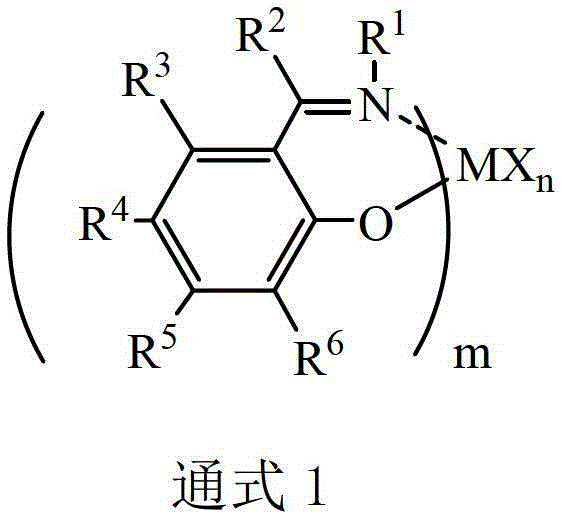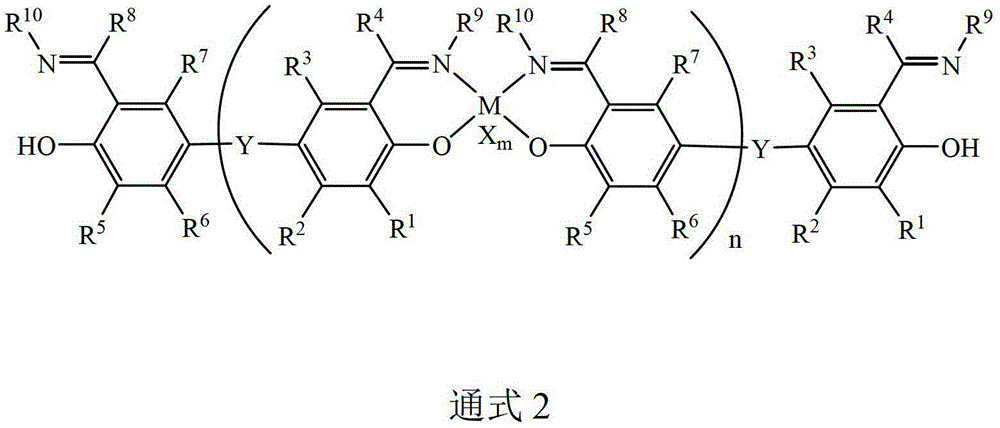Supported non-metallocene catalyst used for ethylene polymerization
A non-metallocene and ethylene polymerization technology, which is applied in the field of preparation of supported non-metallocene catalysts, can solve the problems of complex preparation methods of supported catalysts, limited industrial application range, and short activity duration.
- Summary
- Abstract
- Description
- Claims
- Application Information
AI Technical Summary
Problems solved by technology
Method used
Image
Examples
Embodiment 1
[0182] (1) Preparation of chlorinated hydrocarbyl silicon / silica gel support
[0183] Under the protection of nitrogen, take 2.5 grams of dry silica gel carrier and put it into a glass reactor, add 100 ml of dried hexane, disperse into a suspension, add 1 ml of SiCl 2 (n-Bu) 2 , start stirring, heat up to 30° C., react for 4 hours, and dry in vacuum to obtain a solid powder with good fluidity.
[0184] (2) Preparation of alkyl aluminoxane / chlorinated hydrocarbyl silicon / silica gel support
[0185] Under nitrogen protection, take 5.0 grams of the modified silica gel carrier obtained above and add it to a glass reactor, add 60 milliliters of dried toluene, disperse into a suspension, and add 18 milliliters of 10 wt% MAO (methylaluminoxane) toluene solution , heated to 50 ° C, stirred for 4 hours, then washed three times with 50 ml × 3 toluene, then washed with hexane, and dried in vacuum to obtain a solid powder with good fluidity, that is, a silica gel carrier containing meth...
Embodiment 2
[0195] (1) Preparation of chlorinated hydrocarbyl silicon / silica gel support
[0196] With embodiment 1 step (1), only SiCl in embodiment 1 2 (n-Bu) 2 Change to SiCl 4 .
[0197] (2) Preparation of alkyl aluminoxane / chlorinated hydrocarbyl silicon / silica gel support
[0198] Same as step (2) of Example 1.
[0199] (3) Preparation of supported non-metallocene catalyst B
[0200] Same as Example 1 step (4), only 0.168 grams of bis-[N-(3-tert-butyl-o-hydroxybenzylidene) cyclohexylamine] zirconium dichloride in Example 1 is replaced by 0.152 grams [bis -[N-(3-tert-butyl-o-hydroxybenzylidene) aniline] titanium dichloride] (L 2 ) 2 TiCl 2 (See below for its structure, see literature for its synthesis, Chemistry Letters, 1999, 1065), and obtain a supported non-metallocene catalyst B. Characterized by ICP, in catalyst B, the weight content of Ti is 0.31%, and the weight content of Al is 11.12%.
[0201]
Embodiment 3
[0203] (1), (2) are the same as the preparation methods of (1) and (2) in Example 2.
[0204] (3) Preparation of supported non-metallocene catalyst C
[0205] Same as Example 1 step (3), only 0.168 grams of bis-[N-(3-tert-butyl-o-hydroxybenzylidene) cyclohexylamine] zirconium dichloride in Example 1 is replaced by 0.198 grams [bis -[N-(3-phenyl-o-hydroxybenzylidene) aniline] titanium dichloride] ((L 3 ) 2 TiCl 2 (see below for its structure), and its synthesis is shown in literature Chemistry Letters, 1999, 1065), and a supported non-metallocene catalyst C is obtained. Characterized by ICP, in catalyst C, the weight content of Ti is 0.36%, and the weight content of Al is 11.19%.
[0206]
PUM
 Login to View More
Login to View More Abstract
Description
Claims
Application Information
 Login to View More
Login to View More - R&D
- Intellectual Property
- Life Sciences
- Materials
- Tech Scout
- Unparalleled Data Quality
- Higher Quality Content
- 60% Fewer Hallucinations
Browse by: Latest US Patents, China's latest patents, Technical Efficacy Thesaurus, Application Domain, Technology Topic, Popular Technical Reports.
© 2025 PatSnap. All rights reserved.Legal|Privacy policy|Modern Slavery Act Transparency Statement|Sitemap|About US| Contact US: help@patsnap.com



